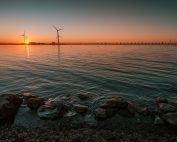Poland is currently a thriving market for renewable energy sources, in particular wind energy. The country has aspirations to develop offshore wind energy in the Baltic Sea. Such large deposits of emission-free energy open up the opportunity to develop green hydrogen production. In Copenhagen, we talked to Janusz Gajowiecki, President of the Polish Wind Energy Association (PWEA). The industry organisation is one of the publishers of the „Green Hydrogen from RES in Poland” report.
The „Green Hydrogen from Renewable Energy Sources in Poland” report is the first comprehensive study that takes up the issue of green hydrogen in a holistic manner. It presents the current state of the hydrogen market and prospects for its development in the future. During Electric City 2021 in Copenhagen, the authors announced the official premiere of the report, which took place on 7 December.
Poland has a great potential for green hydrogen production, which is confirmed by the adopted national strategy for development of the hydrogen economy (NDS). However, for this to happen, it is necessary to remove a number of barriers, especially those currently blocking the development of renewable sources, among them the distance law introducing the 10H rule.
Janusz Gajowiecki, President of the Polish Wind Energy Association, indicated that the Polish industry is very exciting. During Electric City 2021, the report’s authors shared the report’s key findings with guests. Poland can carry out a green transformation in the European Union.
“We believe that it is possible for Poland to become a significant member, a leader in the field of hydrogen. To achieve this, the report indicates strict solutions. We need to make the transition to green hydrogen, the one that is prominent in the European Union and is being pushed through by the European Commission using many of the tools available today. This means that new capacity must be created in Poland from a large number of indirect renewable sources, such as onshore wind, offshore wind, and photovoltaics. These quantities are much higher than those available today in the Polish Energy Policy for 2030 and 2040 (PEP 2040). The transformation situation in the energy sector is very dynamic, and it is crucial for the Climate Ministry and the government to be up to date with developments and changes in the European market”, Gajowiecki pointed out.
He added that it is necessary to be clear about the outcome and the discussion of the transformation in the European Union.
“First of all, we need to talk about electrification of the energy system, transfer, the economy, which is 70 percent of the activities that can be done. This means that electrification is much cheaper than a hydrogen strategy for Europe, for end consumers. What we can do today to become electrified is to follow this and make it as cheap as possible. In sectors where electrification is not possible, we have a lot to do in terms of hydrogen strategy and of course green hydrogen”, added the PWEA president.














